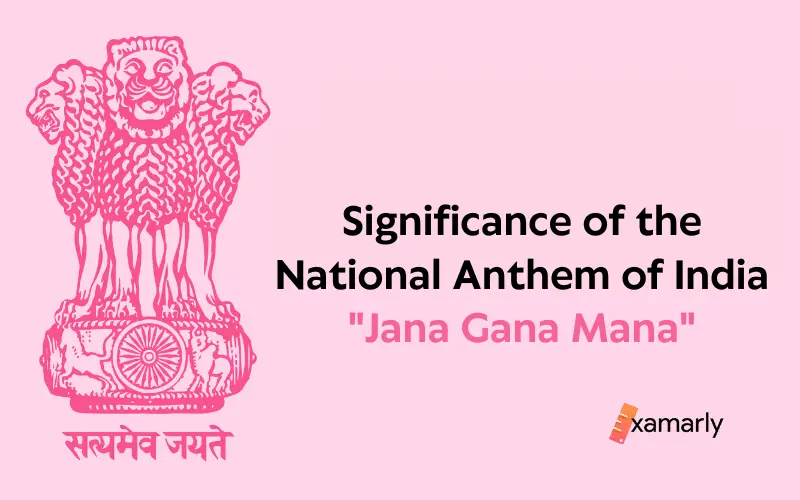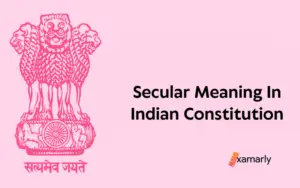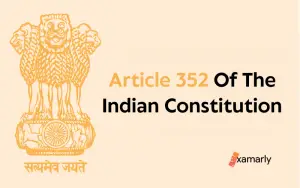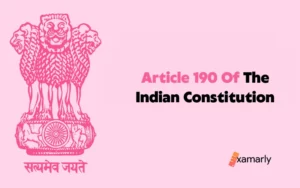We all feel patriotic when we hear the National Anthem or “Jana Gana Mana”. Nobel Laureate Rabindranath Tagore wrote it. It is one of the National Symbols of India. It holds immense significance in terms of National value.
We will read about the meaning, significance of the National Anthem of India, and other significant facts. Read on to know all this and its importance in terms of UPSC preparation. Its simple lyrics convey a powerful message that can be shared with all generations.
- The Message Behind India's "Jana Gana Mana"
- 27th of December has great significance for India's national anthem, Why?
- Importance of India's National Anthem
- Hindi Words to the National Anthem
- The National Anthem, Sung in English
- Important Facts and the History Of Jana Gana Mana
- Difference Between the National Anthem of India and the National Song of India
- Code of Conduct
- Why Read About the Jana Gana Mana?
- Conclusion
- FAQ's
The Message Behind India’s “Jana Gana Mana”
Sadhu Bhasha, a Sanskritized variety of Bengali, was the original language of Jana Gana Mana’s composition. Hence the original song was written in Bengali and Abid Ali translated the beautiful national anthem into Urdu.
The tone and speed that it should be sung take 52 seconds to complete. It is quite literal to translate the Indian national anthem from the Indian language. Most words in the original have the same meaning in the English translation, but the lyric loses some of the poetry.
The poem, however, is considered to be one of the most important works of Indian literature. These lyrics serve two purposes: they are a celebration of India’s diversity and also a call for unity.
The song depicts the cultural diversity and religious unity of the Indian nation. Although it is very simple, this song holds deep meaning for Indians and has been a family tradition. It is sung by many people, both Hindus and Muslims alike.
By deciding on it as our national anthem when he was in Germany, Subhas Chandra Bose also left his mark on the song.
Rabindranath Tagore’s “Bharoto Bhagyo Bidhata”, which was the parent song for the National Anthem has five verses. It was first published in a Bengali Magazine by the name Tatwabodhini Patrika. Only the first verse has been adapted to become the National Anthem of India.
The whole literal translation in English has been given below:
Thou art the ruler of the minds of all people,
dispenser of India’s destiny.
Thy name rouses the hearts of the Punjab, Sindh, Gujarat, and Maratha,
of the Dravida, Orissa, and Bengal.
It echoes in the hills of the Vindhyas and Himalayas, mingles in the music of the Jamuna and Ganges
and is chanted by the waves of the Indian Sea.
They pray for thy blessings and sing thy praise.
The saving of all people waits in thy hand,
thou dispenser of India’s destiny.
Victory, Victory, Victory to thee.
27th of December has great significance for India’s national anthem, Why?
The Indian national anthem has special significance on December 27. The premiere took place on December 27, 1911, in Calcutta, during the 27th session of the Indian National Congress. It had never before been sung at a social gathering.
Importance of India’s National Anthem
Jana Gana Mana is one of the most powerful expressions of a country’s independence. India is a country with several languages and dialects. Jana Gana Mana is universally understood throughout India, fostering a sentiment of oneness among these disparate languages.
The Indian Anthem appropriately expresses the traditions and principles that continue to serve as the country’s backbone.
It contributes to the acceptance and integration of the character of Indian culture, as well as its tolerance for variety. Jana Gana Mana’s solemn recitation appeals to the nation’s patriotic feelings and helps bring people of different backgrounds together under a common banner.
It is officially an expression of the National Identity of India and a symbol of National Respect for the Indian people.
Hindi Words to the National Anthem
जन-गण-मन अधिनायक जय हे,
भारत भाग्य विधाता!
पंजाब-सिंध-गुजरात-मराठा,
द्राविड़-उत्कल-बंग
विंध्य हिमाचल यमुना गंगा,
उच्छल जलधि तरंग
तव शुभ नामे जागे,
तव शुभाशीष मागे
गाहे तव जय गाथा।
जन-गण-मंगलदायक जय हे,
भारत भाग्य विधाता!
जय हे! जय हे! जय हे!
जय जय जय जय हे!
The National Anthem, Sung in English
Jana-gana-mana-adhinâyaka jaya he
Bhârata-bhâgya-vidhâtâ
Pãjâba-Sindh-Gujarâta-Marâṭhâ
Drâviḍa-Utkala-Bãga
Vĩdhya-Himâcala-Yamunâ-Gãgâ
Ucchala-jaladhi-tarãga
Tava shubha nâme jâge,
Tava shubha âshîṣa mẫge,
Gâhe tava jaya-gâthâ.
Jana-gaṇa-mãgaladâyaka jaya he
Bhârata-bhâgya-vidhâtâ.
Jaya he, jaya he, jaya he,
Jaya jaya jaya jaya he!
Important Facts and the History Of Jana Gana Mana
- The Indian National Congress hosted the first public performance of this Jana Gana Mana on December 27, 1911, in Calcutta in its twenty-seventh session.
- The Bengali poet and playwright Rabindranath Tagore wrote it.
- The Raag used in the National Anthem of India is Raag Alhaiya Bilawal.
- Herbert Murrill composed an orchestral/choral adaptation at the request of Nehru. The duration of the national anthem when sung in its more formal form is 52 seconds.
- Bengali was the original language used to compose Jana Gana Mana. Late poet Tagore translated it into English in February 1919.
- The first time Tagore’s translation of the National Anthem was performed in Delhi Durbar when Queen Mary and King George V were crowned. It was written during the 1911 visit of King George V and Queen Mary to India.
- The original version contains five Bengali verses, each describing the country’s struggle for independence and the values and culture it embodies.
- Tagore collaborated with Margaret Cousins, wife of Irish poet James Cousins, to write the English version, which is known as the “Morning Song of India”.
- It was originally in Bengali and was adopted as the National Anthem of India by the Constituent Assembly on 24 January 1950. The formal declaration was made by President Rajendra Prasad.
- After India won its independence, the first time its Constituent Assembly met as an independent body, they all sang Jana Gana Mana to wrap off the session.
- The Supreme Court of India, by order, made it mandatory that the National Anthem in Cinema halls be played before every movie show. From then on, the National Anthem in cinema halls is played with a picture of the National Flag.
Difference Between the National Anthem of India and the National Song of India
If you were to ask anyone to name the anthem of India, you’d probably get different answers. While both are patriotic songs they carry different meanings.
The National Anthem of India has a more serious tone and is a representation of India’s historical past. But the National Song portrays unity among all Indian people.
Both anthems are meant to express pride in our nation. Both anthems are meant to convey a single sentiment.
| National Anthem – Jana Gana Mana | National Song – Vande Mataram |
| The history and culture of India are reflected in the National Anthem. | Citizens of India relate to the National Song at many levels. |
| The National Anthem is very particular about pronunciation, tone and tune, and specific timings. These all factors should be adhered to by anyone who’s singing it on any given occasion. | The National Song can have factors influencing its different variations. These factors can be linguistic or cultural factors. |
| Nobel Laureate Rabindranath Tagore wrote and composed it in the year 1911. | In the 1870s, The National Song was composed by Bankim Chandra Chatterjee. |
| Article 51A of the Indian Constitution honours the National Anthem as one of the fundamental duties that a citizen of India should adhere to. | The National Song Vande Mataram does not enjoy any such privileges. |
| The Indian Parliament has made singing the National Anthem mandatory on specific occasions. | Although the National Song has the same reverence as the National Anthem, it is not mandatory to sing Vande Mataram on any occasion. |
Code of Conduct
There are several guidelines regarding the singing of the National Anthem of India. These guidelines are outlined in the Prevention of Insults to National Honour Act, of 1971.
Offences under this act may result in imprisonment of up to three years, as well as monetary fines. In addition to following the guidelines, it is advisable to sing the National Anthem in unison, especially when the National Flag is being unfurled.
Following is the Code of Conduct for Indian Citizens on the occasion that the National Anthem is being played:
- The person should stand up with attention.
- The head of the person should be held high, signifying pride and proper respect.
- The person should be looking forward in a straight line.
- There should not be made any parody or distortion of the originally accepted version of the National Anthem.
Why Read About the Jana Gana Mana?
The National Anthem of India is an incredibly moving song that has been sung for over 100 years. This powerful song is an expression of India’s culture and history, and a strong catalyst for pride.
The anthem’s lyrics reflect India’s diversity and unity, as well as the emotions expressed by its citizens. It reflects the cultural ethos and values of India.
The making and adoption of the National Anthem are linked to various historical events that can come in handy while preparing for the UPSC Civil Services Examination.
In the type of exam that UPSC CSE is anything can come from any topic, so it is better to be prepared than later regret it.
Questions related to National Anthem can also be asked in the interview phase as timely debates over it have been sparked in many instances in recent times.
Conclusion
The National Anthem of India is an excellent representation of India’s cultural heritage and traditions.
It has been much debated that it was sung to appease British king-emperor George V, who was the only king of England to visit India. However, the late poet Rabindranath Tagore himself refuted any such claims.
Another version of the National Anthem was written by Netaji Subhash Chandra Bose known as “Shubh Sukh Chain” or the 55-second song which was set to tune by Captain Ram Singh Thakur.
It was sung in the same tone and is said to be a re-imagined for the Provisional Government of free India. It was written in 1943.
FAQ’s
Who Wrote The National Anthem Of India And Why Is It Considered Our National Pride?
The national anthem of India is written by Rabindranath Tagore. Like other national emblems, the national anthem embodies a nation’s heritage, history, and beliefs. As a result, it encourages patriotism among the populace and serves to remind them of the greatness, beauty, and rich history of their country.
Which Is The National Anthem Of India And When Was It Adapted?
The Indian National Anthem that we know today is the first stanza of ‘Bharoto Bhagyo Bidhata’, a Bengali hymn written by Rabindranath Tagore. ‘Jana Gana Mana’ was adopted as the National Anthem of India on the last day of the Constituent Assembly, i.e. 24th January 1950.
By Law, How Long Should It Take To Sing Jana Gana Mana?
The full rendition lasts 52 seconds, whereas the abbreviated version lasts just 20 seconds.
How Many National Symbols Does India Have? Name Them.
The 17 National Symbols of India are as follows:
National Flag
Tiranga
National Anthem
Jana Gana Mana
National Calendar
Saka calendar
National Song
Vande Mataram
National Emblem
National Emblem of India
National Fruit
Mango
National River
Ganga
National Animal
Royal Bengal Tiger
National Tree
Indian Banyan
National Aquatic Animal
Ganges River Dolphin
National Bird
Indian Peacock
National Currency
Indian Rupee
National Reptile
King Cobra
National Heritage Animal
Indian Elephant
National Flower
Lotus
National Vegetable
Pumpkin
Oath of Allegiance
National Pledge
When was the song first sung?
Tagore first sang the song outside of Calcutta on February 28, 1919, during a session at Besant Theosophical College in Madanapalle, Andhra Pradesh.






